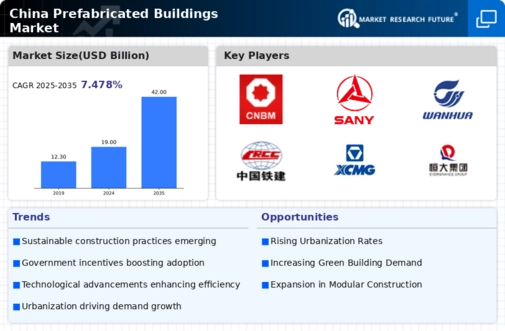Cost Efficiency and Time Savings
Cost efficiency remains a pivotal driver for the prefabricated buildings market in China. The construction industry faces rising labor costs and material prices, prompting developers to seek more economical solutions. Prefabricated buildings offer substantial savings in both time and money, as they can be manufactured off-site and assembled quickly on location. Reports indicate that projects utilizing prefabricated methods can reduce construction time by up to 50%, which translates to lower labor costs and faster project turnover. Additionally, the reduced waste associated with prefabricated construction methods contributes to overall cost savings. As developers increasingly recognize these advantages, the prefabricated buildings market is poised for growth, appealing to both residential and commercial sectors looking to optimize their investments.
Government Initiatives and Policies
The Chinese government actively promotes the prefabricated buildings market through various initiatives and policies aimed at enhancing construction efficiency and sustainability. Recent regulations encourage the use of prefabricated components in urban development projects, which aligns with national goals for reducing carbon emissions. In 2023, the government allocated approximately $10 billion to support the development of prefabricated construction technologies. This funding is expected to stimulate innovation and increase the adoption of prefabricated buildings across the country. Furthermore, local governments are incentivizing developers to incorporate prefabricated solutions in their projects, which could lead to a significant increase in market share for this sector. As a result, the prefabricated buildings market is likely to experience robust growth driven by supportive governmental frameworks and financial backing.
Technological Integration and Innovation
The integration of advanced technologies in the prefabricated buildings market is transforming construction practices in China. Innovations such as Building Information Modeling (BIM) and automation in manufacturing processes enhance precision and efficiency. These technologies facilitate better project management and reduce errors during construction, which is particularly beneficial in a market that demands high-quality standards. Furthermore, the adoption of smart building technologies within prefabricated structures is gaining traction, appealing to environmentally conscious consumers. As these innovations continue to evolve, they are likely to drive the growth of the prefabricated buildings market, making it more competitive and attractive to investors and developers alike.
Rising Urban Population and Housing Shortage
China's rapid urbanization has led to a significant increase in urban population, creating a pressing demand for housing solutions. The prefabricated buildings market is well-positioned to address this challenge, as these structures can be deployed quickly to meet the urgent need for affordable housing. With over 60% of the population expected to reside in urban areas by 2030, the demand for efficient construction methods is paramount. Prefabricated buildings can be produced at scale, allowing for the swift development of residential units. In 2025, it is estimated that the market for prefabricated housing could reach $50 billion, driven by the need to alleviate housing shortages in major cities. This trend underscores the potential for prefabricated buildings to play a crucial role in urban development strategies.
Environmental Sustainability and Resource Efficiency
The increasing emphasis on environmental sustainability is a significant driver for the prefabricated buildings market in China. As the country grapples with pollution and resource depletion, there is a growing demand for construction methods that minimize environmental impact. Prefabricated buildings are inherently more resource-efficient, as they generate less waste during production and construction. Moreover, these structures can be designed to incorporate energy-efficient systems, further reducing their carbon footprint. In 2025, it is projected that the market for sustainable prefabricated buildings could account for over 30% of total construction activities in urban areas. This shift towards eco-friendly construction practices is likely to bolster the prefabricated buildings market, aligning with national sustainability goals.

















Leave a Comment